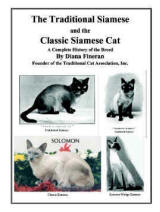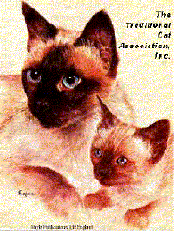|
Departments
eBook now Available!
|
Exclusive - THE book on Traditional & Classic
Siamese cats

Written by the Founder of TCA, Inc.
Tullycrine
Affordable
Web Design
|
|
|
WHISKERS
By Diana Fineran
There are long ones, short ones and those in between.
Different from fur, which is always shorter and has a knap to it, showing the
direction the fur lies, whiskers grow straight out from the skin.
Their correct name is tactile hairs or sinus hairs. (Hmmm, I wonder if
those are the same sinus hairs…). The largest number can be found on the sides
of the muzzle, but they can also be found growing from the chin and as eye brows
above the eyes. Eye lashes are not
considered to be the same as whiskers, however.
The stiff whiskers have an inner core containing branches
of the cat’s main facial nerve, called the trigeminal nerve.
A combination of this nerve, with the whiskers and the way the cat uses
them together is considered to be what helps the cat to orient himself in
darkened places. Balance, closeness
to objects or prey, depth perception, and sensitivity to his surroundings gives
the cat an extra sense, that he truly takes advantage of.
The emotional feelings of your
cat can be clearly understood by the way your cat positions his whiskers.
Pulled forward means your cat is happy and relaxed.
Pulled back means your cat is defensive. Pulled straight and spread out
means your cat is displeased about something and could lash out.
The
cat is one animal known to use its facial muscles to smile, adding to their
expressiveness. So there you have it. These
sharp tipped instruments are a window to your cat’s state of mind, ready for
you to “read” if you are paying attention.
|
|
|

 The
Traditional Cat Association,
Inc.©1987®TM
Official Website
The
Traditional Cat Association,
Inc.©1987®TM
Official Website